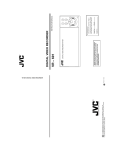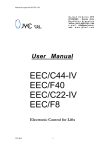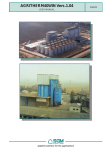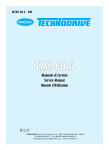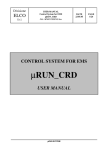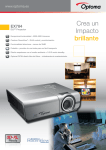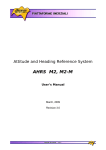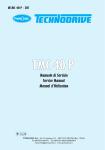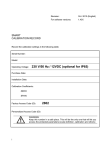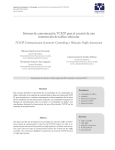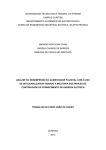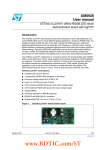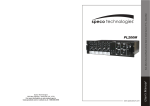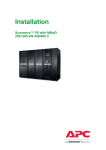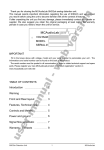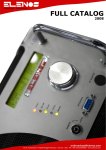Download RV-I User`s Handbook
Transcript
OVERCURRENT PROTECTION RELAY RV-I GENERAL MODEL USER’S HANDBOOK DOC 10/06 - V 7.1 Nº. 651.601.239 0.- INDEX 0.- INDEX............................................................................................................................................... II 1 OBJECT ......................................................................................................................................... 1 2 RANGE .......................................................................................................................................... 1 3 OPERATING PRINCIPLES .................................................................................................. 1 4 RECEPTION & STORAGE..................................................................................................... 1 5 OPERATIONAL CHARACTERISTICS.............................................................................. 1 5.1.- PROTECTIVE FUNCTIONS ............................................................................................ 1 5.2.- RELAY SETTING............................................................................................................... 2 5.3.- OUTPUTS............................................................................................................................ 2 5.4.- DIGITAL INPUT ................................................................................................................ 2 5.5.- CURRENT INPUTS ........................................................................................................... 2 5.6.- LED’S ................................................................................................................................... 3 5.7.- SELF DIAGNOSIS............................................................................................................ 3 5.8.- COMMUNICATIONS ........................................................................................................ 3 6 TECHNICAL CHARACTERISTICS .................................................................................... 5 7.- OPERATING INSTRUCTIONS.............................................................................................. 10 7.1.- USER INTERFACE.......................................................................................................... 10 7.2.- KEYBOARD FUNCTIONS ............................................................................................. 11 7.3.- RELAY ADJUSTMENT & MENU SEQUENCE ........................................................... 11 7.4.- ALARM SCREEN........................................................................... 16 7.5.- COMMUNICATION PROBLEMS.................................................................................. 16 8.- CONSTRUCTION FEATURES ................................................................................................ 17 9.- POSITION OF EXTERIOR TERMINALS .......................................................................... 18 10.- EXTERNAL CONNECTIONS................................................................................................ 20 11.- OUTSIDE DIMENSIONS ...................................................................................................... 26 APPENDIX I: MODEL SELECTION TABLE ............................................................................ 27 APPENDIX II: CHARACTERISTICS CURVES ...................................................................... 28 APENDIX III: OPERATING GUIDE LINE.............................................................................. 34 II RV-I USER’S HANDBOOK Nº 651.601.239 1 4 OBJECT RECEPTION & STORAGE This manual is intended to help users set up and operate the RV overcurrent protection relay The RV-I protection relay is supplied with packaging capable of protecting it during normal handling for equipment of this type. (RV-I). If it is not to be installed immediately, it should be kept in the packaging, properly closed and in indoor conditions, protected from rain, dust, vibration, etc. 2 RANGE The new family of overcurrent protection relays, RV comprises the following models: • Check also that the data on the ID plate matches the order data. RV-ITN: Overcurrent protection relay 3 phases + neutral. • If the packaging is damaged or it is believed that the unit may have been incorrectly handled in transit, the carrier, the relevant insurance company and the manufacturing plant should be informed forthwith. 5 RV-IBN: Overcurrent protection relay OPERATIONAL CHARACTERISTICS 2 phases + neutral. • • RV-IT: Overcurrent protection relay 5.1.- Protective Functions 3 phases. The RV-I protection relay features the following protective functions for phase and neutral: • RV-IMA: Single-phase overcurrent protection relay with armonic filter. • 3 Instantaneous unit (50): - Instantaneous operation. - Additional time. Time unit (51): - Definite time. - Operation by curves: - Inverse. OPERATING PRINCIPLES - Very inverse. - Extremely inverse. The RV-I is an overcurrent protection relay with instantaneous (50) and time (51) trip characteristics, designed to protect equipment and facilities of grounding (homopolar) or shortcircuit faults between phases. - Customer’s special curve (optional). It provides RMS measure of each phase controled and records information of the last fault. Its small size makes the RV-I ideal for applications and facilities requiring highly compact equipment. It can be installed quickly and easily on a 35 mm rail as per DIN EN 50022. 1 RV-I USER’S HANDBOOK Nº 651.601.239 5.2.- Relay setting 5.4.- Digital input The relay can be adjusted: • Via the display and keyboard on its front (user interface). • Via a local PC using the RS-232 port on the front of the relay. • Via the RS-485 port, through the connection terminals. The relay has a digital input whose function can be configured by the user from the following range of options: Option 0 Disabled 1 Trip Disabled. It disables all trips and overrides ongoing trips. 2 RESET of the trip signal and last fault data. 5.3.- Outputs The RV-I protection relay has two or three output relays (depending on the model) whose function can be configured by the user from the following range of options: Function Selection 0 Relay disabled 1 General tripping 2 Phase instantaneous 3 Neutral instantaneous 4 Phase timed 5 Neutral timed 6 Phase start-up 7 Neutral start-up 8 Instantaneous disabled 9 Phase tripping (instantaneous or timed) 10 Neutral tripping (instantaneous or timed 11 Instantaneous tripping (phase and neutral) 12 Timed tripping (phase and neutral) 13 Alarm indicating RV-I not operational. In normal circumstances with the RV-I relay operational the output relay is powered up. Function 5.5.- Current Inputs These are powered by an external current transformer which adjusts the primary current to the secondary measuring current of the relay (see connection diagrams in Section 10). This instrument transformer should be powerful enough to power the measuring circuit (see Section 6: Technical Characteristics). The RV-I overcurrent relay can be connected directly, with no need for external current transformers, in circuits with rated current levels coincidental whith the relay itself. The maximum current levels are shown in section 6 (Technical Characteristics). 2 RV-I USER’S HANDBOOK Nº 651.601.239 5.6.- LED’s • Configuration: adjust & display of settings. Apart from the display itself the RV-I relay has 9 LED’s on its front panel: • Measurements: RMS current input levels. Text ON I >> t I >> I> t I> Colour Meaning green Relay operational red Instantaneous phase start-up (50) red Instantaneous phase tripping red Timed phase start-up (51) red Timed phase tripping k I red Instantaneous neutral start-up (50N) t red Instantaneous neutral tripping red Timed neutral start-up (51N) red Timed neutral tripping >> I > I >t k Internal status: indication of relay functions enabled, and whether they are tripped or not. The status and configuration of the relay outputs and the digital input are also shown. • Last trip: When a trip occurs the relevant LED indicates the trip and the display reads ‘FALT’. The Up/ Down keys (1 and 3) can be used to display the currents measured in each phase at the moment when the fault occurred. This information can also be consulted via the keyboard or through the user interface until a Reset command is given through one of these channels or through the digital input. ADVICE: It is recomended to use the last version of software. Available in CD with the relay and in >> I • www.arteche.com COMMUNICATION CHARACTERISTICS: These LED’s remain on until they are acknowledged manually (RESET) or via the digital input. They also act as indicators in the relay adjustment process. 5.7.- Self Diagnosis The relay continually checks the status of its own internal components, program cycle monitoring, power supply, etc. • Communications are based on the MODBUSRTU protocol. • The PC is always the master in communications, and the RS-232 port always has priority over the RS-485. • The RS-232 port is fitted with a DB9 female connector on the front of the relay. • Communication through the RS-485 port is via connection terminals. This port is galvanically isolated and needs a 5 Vdc external power supply. • Baud rates can be configured from the keyboard or the PC. The options available are 4800, 9600 and 19200 bps. The configuration of the PC port that it is connected with the net RS485 must be like relay rated. • The relay is allocated an ID number which can be selected between 1 and 240. This number identify each relay of an installation for MODBUS-RTU communications via RS 485. It can be modified only through the relay keyboard, and not through communications channels. The results of these checks are reflected in the following two components: • Output relay for internal failure alarm, if output option 13 is selected (see 5.3 above); • Green “Relay Operational” indicator LED. 5.8.- Communications The user can communicate with the protection relay to configure its operational parameters and check its status. The information communicated is as follows: 3 RV-I USER’S HANDBOOK Nº 651.601.239 RS-232 CONNECTOR PC RV RxPC 2 3 TxRV TxPC 3 2 RxRV GND 5 5 GND DTR 4 DSR 6 CTS 7 RTS 8 DB9 Hembra 1 2 6 DB9 Macho 3 7 4 8 5 9 4 RV-I USER’S HANDBOOK Nº 651.601.239 6 TECHNICAL CHARACTERISTICS Measuring rates; Setting ranges: Additional time: Instantaneous unit: Instantaneous unit: Current rated Range Adjust steps Current 5A 0.5÷60 A 0.1 A Phase & Neutral 1A 0.25÷15 A 0.01 A Phase & Neutral 0.25 A 0.05÷3 A 0.01 A Phase & Neutral 0.1 A 0.02÷1.5 A 0.01 A 0.01 A 0.004÷0.035 0.01 A (s) Additional time: 0 ÷ 2 s. Adjustment steps: 0.01 s. Timed unit: • Definite time: 0 ÷ 12 s.; Adjustment step 0.01 s. • BS-IEC Curves (ANSI as an option) - Inverse Phase & Neutral - Very inverse - Extremely inverse 0.001 A Neutral - Customer’s special curve 0.005÷0.10 0.001 A Neutral Current rated Range Adjust steps Current 5A 0.5 ÷ 12 A 0.1 A Phase & Neutral • Selection of K: 00 ÷ 99; Adjustment step 1. Time unit: 1A 0.25 ÷ 3 A 0.01 A Phase & Neutral 0.25 A 0.05 ÷ 1 A 0.01 A Phase & Neutral 0.1 A 0.02÷0.3 A 0.01 A Phase & Neutral 0.01 A 0.004÷0.02 0.001 A Neutral 0.01 A (s) 0.005÷0.03 0.001 A Neutral BS IEC ANSI Curve Nº K K 00 0.05 0.5 01 0.06 0.6 ... ... ... 99 1.04 10.4 The formulae applicable to each curve model are detailed below. This enables the exact response point of the relay to be calculated. The subsequent graphs sum up the results. Instantaneous unit override: Select: Yes or No. 5 RV-I USER’S HANDBOOK Nº 651.601.239 IEC 60255-3; BS-142 CURVES t= k (I Ia ) a −1 ANSI; IEEE C 37-2 CURVES As an option and by special order, the RV-I protection relay can be pre-programmed with ANSI curves (IEEE C 37-2). ⋅K The formula and parameters involved in calculating these curves are indicated below: t: trip time in seconds ( I: Measured current. t (s) = K ⋅ A + B (I Ia − C ) + D (I Ia − C )2 + E (I Ia − C )3 Ia: Setting or start-up current. I/Ia: t: trip time in seconds. nº of time setting or start-up current. K: Multiplication factor (“time index”). Varies between 0.05 and 1.04 in steps of 0.01. Curve A Curve B Curve C Inverse Very inverse Extremely inverse k 0.14 13.5 80 a 0.02 1 2 I: Measured current. Ia: Setting or start-up current. I/Ia: nº of time setting or start-up current. K: Multiplication factor (“time index”). between 0.5 and 10.4 in steps of 0.1. Varies A, B, C, D, E: Constants depending on curve type. (See curves in Appendix II). Cur. Inverse Very inverse Extremely inverse A 0.0274 0.0615 0.0399 B 2.2614 0.7989 0.2294 C 0.3000 0.3400 0.5000 D -4.1899 -0.2840 3.0094 E 9.1272 4.0505 0.7222 (See curves in Appendix II). 6 ) RV-I USER’S HANDBOOK Nº 651.601.239 MEASURING CIRCUIT Accuracy: Accuracy in measuring range: ± 5% Repetition: ± 1% Accuracy in set times: ± 5%; min. 0.03 s. Accuracy in dependent times: as per BS 142 Repetition: ± 1%; min. 0.03 s. Power consumption: < 100 mVA Return percentage: > 90 % Max. permanent current: 3 x In (Rated current 5 A); 5 x In (rest of rates) Max. instantaneous current: 300 A, 1 s (Rated Current 5 A). 100 A, 1 s (Rated Current 1A and 0.25A ). 30 A, 1 s (Rated current 0.1 A) 2 A, 1 s (Rated Current 0.01 A < 50 ms (3 * adjusted Iinst.) Instantaneous trip time: < 60 ms (1,2 * adjusted Iinst.). AUXILIARY POWER SUPPLY Aux. power supply calibrations Digital input voltage range 24-125 Vdc or 24-110 Vac; ±20% 24-125 Vdc 90-250 Vdc or 80-230 Vac; ±20% 90-250 Vdc 4÷9W Power consumption: OUTPUT CONTACTS V max.: 380 Vac, 125 Vdc Permanent lcurrent: 10 A Making capacity: 10 A Breaking capacity: Cos φ= 1: 2.500 VA; 300 W Cos φ= 0,4; L/R= 7 ms: 1.875 VA; 150 W Electrical lifetime: 105 operations (at 1800 operations per hour). Mechanical lifetime: 2 * 107 operations (at 1800 operations per hour). 7 RV-I USER’S HANDBOOK Nº 651.601.239 EMC TESTS Electrostatic discharge EN 61000-4-2 Air mode 15 kV Contact mode 8 kV Radiated electromagnetic field EN 61000-4-3 10 V/m Fast transient (burst) EN 61000-4-4 4 kV / 5 kHz Impulse test voltage (surge) EN 61000-4-5 Common mode 4 kV Differential mode 2 kV Conducted disturbances induced by EN 61000-4-6 radio-frequency fields 10 V Power frecuency magnetic field EN 61000-4-8 permanent 100 A/m during 1 s 1000 A/m Damped oscillatory magnetic field EN 61000-4-10 at 1 MHz & 0.1 MHz 100 A/m Oscillatory waves EN-61000-4-12 Common mode 2.5 kV 1 MHz differential mode 1 kV Radiated electromagnetic field ENV-50204 from digital radio-telephones 10 V/m (900 MHz & 1.89 GHz) Interruptions & ripples IEC 60255-11 in D/C power supply 1 MHz disturbances IEC 60255-22-1 Emission EN 55022 8 RV-I USER’S HANDBOOK Nº 651.601.239 CLIMATE & ELECTRICAL SAFETY TESTS Electrical tests: IEC 60255-5 Dielectric test 2 kV / 50 Hz / 1 min High frequency 2,5 kV / 1 MHz / IEC 60255-22-1 1 kV / 1 MHz / IEC 60255-22-1 Surge withstand 5 kV / 1.2 / 50 µs Insulation 500 Vdc independent circuits Climate tests: IEC 60068-2 Cold temperature -20º C Dry heat test +60º C Humid temp. test +55º C, 93% humedity Heat shock -40º C, +80º C Storage temp. -30º C, +70º C Cover protection degree: IEC 60529, EN 60529: IP 30 9 RV-I USER’S HANDBOOK Nº 651.601.239 7.- OPERATING INSTRUCTIONS 7.1.- User Interface The user interface of the relay comprises a message and data display unit, LED indicators providing various items of information and a keyboard through which commands and data are input. The characteristics of this user interface are as follows: Four displays with 7 segments and 9 LED’s. One LED is green (OK) and indicates that the protection relay is operating correctly. The full list of LED indications is as follows: Text Colour Meaning green Relay operational ON I >> t I >> I> I> t k I I >> I > >> t I> t k red Instantaneous phase start-up red Instantaneous phase tripping red Timed phase start-up red Timed phase tripping red Instantaneous neutral start-up red Instantaneous neutral tripping red Timed neutral start-up red Timed neutral tripping These LED’s also serve as indicators at various points during the execution of user interface menus via the keyboard and the display units. The relevant indications are listed in point 7.3 (Menu Sequence) below. 10 RV-I USER’S HANDBOOK Nº 651.601.239 7.2.- Keyboard Functions There are 6 keys, with the following functions: ESC USE THIS KEY TO EXIT ANY MENU. THIS ALWAYS RETURNS TO THE INITIAL STATUS, WITH A PROMPT ASKING WHETHER YOU WANT TO STORE THE FIGURES ENTERED IN THE MEMORY IN MENUS WHERE PARAMETERS MAY BE CONFIGURED. “UP” AND “DOWN” KEYS. USED TO SCROLL THROUGH MENU OPTIONS. IN PARAMETER CONFIGURATION MENUS THESE KEYS INCREASE OR DECREASE THE RELEVANT FIGURES. ªTO ACCEPT A FIGURE STRIKE ENTER. ªWHEN ENTER IS STRUCK THE FOLLOWING MENU OPTION APPEARS. “ENTER”. USED TO SELECT A MENU AND ACCEPT A FIGURE. RESET TEST “RESET”. USED TO RESET AN LED FAULT INDICATION. In the CONFIGURATION menu this key is used in setting currents and times to change the digit to be set (decimals, units,etc.). “TEST”. USED TO SIMULATE A FAULT AND CHECK THE RELAY. ALL 4 TRIP LED’S LIGHT UP AND THE SCREEN MESSAGE “FALT” APPEARS. THE RELAY WILL BE BLOCKED WHILE THIS KEY IS PRESSED. THIS KEY DOES NOT ACT IF THE RELAY IS TRIPPED. 7.3.- Relay Adjustment & Menu Sequence The graphics below show the various relay menus, the information appearing on screen and how to set the parameters (adjust) the relay. With the relay operational, the measurement for phase “R” appears on screen. Those of the other phases and the neutral can be viewed sequentially via the Up and Down keys. 11 RV-I USER’S HANDBOOK Nº 651.601.239 Level 1 Level 2 Level 3 Level 4 Comentarios Level 5 R phase measur. Phase R current measurement (secundary) S phase measur. Phase S current measurement (secundary) T phase measur. Phase T current measurement (secundary) Earth measur. Neutral current measurement (secundary) CONFIGURATION PASSWORD INSTANTANEOUS PHASE O/C SETTING I>> TIME Delay time setting Neutral OverCurrent protection (50N) SETTING Ie>> Instantaneous neutral setting PHASE O/C Delay time setting Phase Time OverCurrent protection (51) SETTING I> Phase current setting Time charateristic Time Characteristic selection TIME Delay time or curve setting NEUTRAL O/C Neutral Time OverCurrent protection (51N) SETTING Ie> Neutral current setting Time charateristic Time Characteristic selection TIME Delay time or curve setting Instantaneous disabled Disabled type RELAY RELAY 1 Configuration first relay RELAY 2 Configuration second relay RELAY 3 Configuration thrid relay DIGITAL INPUT Configuration FRECUENCY 50/60 Hz COMUNICATIONS 12 Instantaneous phase setting NEUTRAL O/C TIME TIME CHARACTER. Phase Inst. OverCurrent protection (50) Istantaneous trip disabled possibility Digital input configuration Frecuency setting (analogic inputs) DIRECTION Relay identity number SPEED Communication speed RV-I USER’S HANDBOOK Nº 651.601.239 Nivel 1 Nivel 2 Nivel 3 Nivel 4 CONFIGURATION SIGHT INSTANTANEOUS PHASE O/C SETTING I>> TIME Phase Inst. OverCurrent protection (50) Instantaneous phase setting Delay time setting NEUTRAL O/C Neutral OverCurrent protection (50N) SETTING Ie>> Instantaneous neutral setting TIME TIME CHARACTER. Comentarios Nivel 5 PHASE O/C SETTING I> Time charateristic TIME Delay time setting Phase Time OverCurrent protection (51) Phase current setting Time Characteristic selection Delay time or curve setting NEUTRAL O/C Neutral Time OverCurrent protection (51N) SETTING Ie> Neutral current setting Time charateristic TIME Time Characteristic selection Delay time or curve setting Instantaneous disabled Disabled type RELAY RELAY 1 Configuration first relay RELAY 2 Configuration second relay RELAY 3 Configuration thrid relay DIGITAL INPUT Configuration FRECUENCY 50/60 Hz COMUNICATIONS DIRECtION SPEED Istantaneous trip disabled possibility Digital input configuration Frecuency setting (analogic inputs) Relay identity number Communication speed Instantaneous measuring information (secondary) MEASUREMENT LEVEL 1 TEST EXECUTION PASSWORD OLD PASSWORD Change password NEW PASSWORD Write new password REP. NEW PASSWORD 13 Secuential test proccess of Led's and display Repeat new password RV-I USER’S HANDBOOK Nº 651.601.239 o To change from one screen to the next in the same level, you must push "Down" button, or "Up" button to go to the previous one. o To change the level to the next, you must push "INTRO" button. o If we push "INTRO" in screen "Configuration" the relay ask for a Password. If the password is correct you pass to the first screen of the fourth level. You must push "Down" button to go to the next screen or "Up" button to go to the previous one. In this level it is possible to change the settings, apearing secuentially the different possible settings screens. o To Confirm the settings you must push "ESC" button. In the screen appears the message "VALID?". Push "INTRO" to confirm or "ESC" to mantein the old settings. o When one of the setting digits were blinking, it is possible to change its value pushing "Up" or "Down" buttons. To change the digit, you must push "RESET". o Appendix III shows the different screens of the different menus, secuentially as a summary. The relay keys are associated with the following numbers which are used in password allocation. 1 ESC 2 4 3 5 RESET TEST NB: When RV protection relays leave the factory the password is set at 1111 15 RV-I USER’S HANDBOOK Nº 651.601.239 7.4.- ALARM SCREEN When a fault occurs, the relay display jumps from the menu displayed to the alarm screen. • The relevant LED flashes (I>> o I> o I >> o I >). • The screen message FALt. appears. Strike ENTER and use the Up and Down keys to check the current levels at the time of the fault. The menu is identical to the Instantaneous Measurement menu, except that the LED for the fault flashes. • To revert to initial status strike RESET. ESC Measur.e Alarm MEdI. FALt. RESET RESET MEASURE All menus except Instantaneous Measurements have a 90-second time-out. After that time the unit reverts to its initial status. In Fault Measurements the time-out is 60 seconds. 7.5.- Communication Problems Using the software of the RV protections to communicate with them via RS232 or RS485, it is posible to have some communication problems that software detects, showing an explicative message. The software also detects the setting errors. Next table presents the more common error messages, describing them and giving some indications for its solution. Error message Problem description Failure in It is no possible to communicate with communication RV relay steup Setting is out of Possible cause Solution 1. No RV connected. 3. Connect the RV relay. 2. Communication port not correctly 4. Configurate communication port 1. Change the setting to the closest defined It is no possible to set the value. 1. bounds. The setting is out of the setting range of the RV relay. included in the setting range. Consult User Manual. Wrong password It is no possible to change settings or format. change passcode. 1. Some or al the values are out of 1. Write correct password. 2. Write correct password. range (1 ÷ 5). 2. Some or all of the values have incorrec format. 16 RV-I USER’S HANDBOOK Nº 651.601.239 It is able to have some COMMUNICATION FAILURES when try for ASKING FOR IDENTIFICATION or SENDING OF SETTINGS between relay and RV software. These messages are complete with an error code as follows: Error code Time out Problem description It is no possible to establish communication between relay and SW because of general communicaction failure. Possible cause Solution 1. The relay is not connected. 1. Connect the relay. 2. There is an incorrect connection. 2. Check communication cable. 3. Communication port not correctly 3. Configurate communication port. 4. Correct relay address. 1. Chose RV protection family of the defined. Ilegal datta address It is no possible to establish 4. Incorrect relay address. 1. It is chosen an incorrect RV communication with relay desired protection family. protection relay we need to communicate. Ilegal data value It is no possible to change the settings. 1. The passcode is not of the protection 1. Write correct passcode. relay you desire to communicate. Do not hesitate in contact with us if you can not connect with the RV protection relay. Please send a mail to [email protected] with the reference “Error RV”. Our technical department contact you in a short period of time in order to solve the problem. 8.- CONSTRUCTION FEATURES The RV-I protection relay is supplied in a NORYL self-extinguishing plastic case compliant with standard UL-94, class V0. The box is RAL 7035 grey, and is designed to be installed on a DIN EN 50022 rail as per DIN 43880. 17 RV-I USER’S HANDBOOK Nº 651.601.239 9.- POSITION OF EXTERIOR TERMINALS PIN Connector 1 Connector 2 1 2 3 4 5 6 7 8 9 10 11 12 14 15 16 17 19 20 21 22 23 24 25 26 27 28 29 30 32 33 34 35 Connector 3 Connector 4 Connector 1 RV-ITN RV-IBN RV-IT RV-IMA 1 GND, RS485 X X X X 2 RS485 B (negative) communication pair X X X X 3 RS485 A (positive) communication pair X X X X 4 +5 Vdc, RS485 X X X X 5 Digital input (negative) X X X X 6 Digital input (positive) X X X X 7 Output relay 2 - COMMON X X X X 8 Output relay 2 - NC (normally closed) X X X X 9 Output relay 2 - NO (normally open) X X X X 18 RV-I USER’S HANDBOOK Nº 651.601.239 PIN Connector 2 RV-ITN RV-IBN X X RV-IT RV-IMA 10 Current input 4, output 10 Output relay 3 – Common X 11 Output relay 3 – NC (normally closed) X 12 Current input 4, input 12 Output relay 3 – NO (normally open) 15 Current input 3, output X X 17 Current input 3, input X X X X X X X PIN Connector 3 RV-ITN RV-IBN RV-IT RV-IMA 19 Ground X X X X 21 Vdc or Vac (Aux. power supply without polarity) X X X X 23 Vdc or Vac (Aux. power supply without polarity) X X X X 25 Output relay 1 - NO (normally open) X X X X 26 Output relay 1 – NC (normally closed) X X X X 27 Output relay 1 – COMMON X X X X RV-ITN RV-IBN PIN Connector 4 RV-IT RV-IMA 29 Current input 1, input X X X 30 Current input 1, output X X X 32 Ground X X X 34 Current input 2, input X X X 35 Current input 2, output X X X 19 X RV-I USER’S HANDBOOK Nº 651.601.239 10.- EXTERNAL CONNECTIONS 3 phase + neutral RV-ITN (standard connection) Output contacts programmable by the user. The units leave the factory programmed as follows: Relay nº 1: General trip. Relay nº 2: ALARM: Relay Not Operational. 20 RV-I USER’S HANDBOOK Nº 651.601.239 3 phase + neutral RV-ITN (sensitive ground) Output contacts programmable by the user. The units leave the factory programmed as follows: Relay nº 1: General trip. Relay nº 2: ALARM: Relay Not Operational. 21 RV-I USER’S HANDBOOK Nº 651.601.239 3 phase + neutral RV-IBN (standard connection) Output contacts programmable by the user. The units leave the factory programmed as follows: Relay nº 1: General trip. Relay nº 2: ALARM: Relay Not Operational. 22 RV-I USER’S HANDBOOK Nº 651.601.239 3 phase + neutral RV-ITN (sensitive ground) Output contacts programmable by the user. The units leave the factory programmed as follows: Relay nº 1: General trip. Relay nº 2: ALARM: Relay Not Operational. 23 RV-I USER’S HANDBOOK Nº 651.601.239 3 phase RV-IT (standard connection) Output contacts programmable by the user. The units leave the factory programmed as follows: Relay nº 1: General trip. Relay nº 2: ALARM: Relay Not Operational. Relay nº 3: Phase start-up. 24 RV-I USER’S HANDBOOK Nº 651.601.239 Single phase w/ armonic filter RV-IMA (standard connection) Output contacts programmable by the user. The units leave the factory programmed as follows: Relay nº 1: General trip. Relay nº 2: ALARM: Relay Not Operational. 25 RV-I USER’S HANDBOOK Nº 651.601.239 11.- OUTSIDE DIMENSIONS 26 RV-I USER’S HANDBOOK Nº 651.601.239 APPENDIX I: MODEL SELECTION TABLE MODEL R V - X X X X . X X X 1 0 . 0 0 0 0 FUNCTION Overcurrent – 3 phases + neutral Overcurrent – 3 phases Overcurrent – 2 phases + neutral Overcurrent – single phase w/ filtering of harmonics _ _ _ _ I I I I T T B M AUX. POWER SUPPLY (± 20%) POWER SUPPLY DIG. INPUTS 24 ÷ 125 Vdc / 24 ÷ 110 Vac 24 ÷ 125 Vdc 90 ÷ 250 Vdc / 80 ÷ 230 Vac 90 ÷ 250 Vdc PHASE RATED CURRENT No current 5A 1A 0.25 A 0.1 A N _ N A 0 1 0 1 2 3 4 NEUTRAL RATED CURRENT No current 5A 1A 0.25 A 0.1 A 0.01 A 0.01 A (s) 27 0 1 2 3 4 5 7 RV-I USER’S HANDBOOK Nº 651.601.239 APPENDIX II: CHARACTERISTICS CURVES IEC-60255 / BS-142 CURVE A / INVERSE 1000 TIME (s.) 100 10 Nº CURVA 99 85 75 65 55 45 1 35 25 15 05 - 00 0,1 0 1 2 3 4 5 6 7 8 n · Ia (I/Ia) 28 9 10 11 12 13 14 15 RV-I USER’S HANDBOOK Nº 651.601.239 IEC-60255 / BS-142 CURVE B / VERY INVERSE 1000 100 TIME (s.) 10 Nº CURVE 1 99 85 75 65 55 45 35 25 15 0,1 05 00 0,01 0 1 2 3 4 5 6 7 8 n · Ia (I/Ia) 29 9 10 11 12 13 14 15 RV-I USER’S HANDBOOK Nº 651.601.239 IEC-60255 / BS-142 CURVE C / EXTREMELY INVERSE 1000 100 TIME (s.) 10 1 Nº CURVE 99 85 75 65 55 45 35 25 0,1 15 05 00 0,01 0 1 2 3 4 5 6 7 8 n· Ia(I/Ia) 30 9 10 11 12 13 14 15 RV-I USER’S HANDBOOK Nº 651.601.239 ANSI / IEEE C 37-2 CURVE INVERSE 1000 100 TIME (s.) 10 Nº CURVE 99 85 75 65 55 45 35 1 25 15 05 0,1 00 0,01 0 1 2 3 4 5 6 7 8 n · Ia (I/Ia) 31 9 10 11 12 13 14 15 RV-I USER’S HANDBOOK Nº 651.601.239 ANSI / IEEE C37-2 CURVE VERY INVERSE 1000 100 TIME (s.) 10 Nº CURVE 99 85 75 65 55 45 1 35 25 15 05 0,1 00 0,01 0 1 2 3 4 5 6 7 8 n · Ia (I/Ia) 32 9 10 11 12 13 14 15 RV-I USER’S HANDBOOK Nº 651.601.239 ANSI / IEEE C37-2 CURVE EXTREMELY INVERSE 1000 100 TIME (s.) 10 Nº CURVE 1 99 85 75 65 55 45 35 25 15 0,1 05 00 0,01 0 1 2 3 4 5 6 7 8 n · Ia (I/Ia) 33 9 10 11 12 13 14 15 RV-I USER’S HANDBOOK Nº 651.601.239 APENDIX III: OPERATING GUIDE LINE 34








































